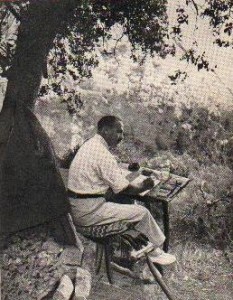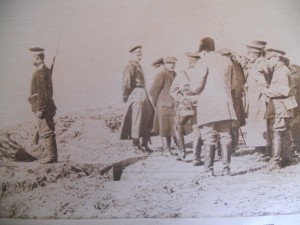Why Used Bookshops Can Be a Writer’s Best Friend
By Sophie Masson | September 14, 2015 |
Browsing on the internet one day, looking up Conan Doyle sites with the vague notion of Sherlock Holmes appearing in a detective novel for young readers I was planning, I stumbled across a casual reference to a certain H. Ashton-Wolfe. Ashton-Wolfe was a writer of true-crime adventure bestsellers, who claimed to know not only Holmes’ creator, as well as the leading lights of the French Sûreté and Scotland Yard, but also just about every famous criminal and outlaw of the day!
Several hurried orders from online used bookshops later, I had built a mini-library of Ashton-Wolfe’s books, with their gorgeously pulpy titles, such as Crimes of Love and Hate, The Thrill of Evil, Outlaws of Modern Days, and The Forgotten Clue. I plunged into the addictive joys not only of the melodramatic and exotic cases recounted in racy prose, but the vain and boastful character of Ashton-Wolfe himself, which infused the stories with unintentional hilarity. So engaging was this combination that I immediately dropped Sherlock in favor of a certain Philip Woodley-Foxe, whose adventures are legendary, not least to himself. You can find him in my mystery novel for young people, The Case of the Diamond Shadow. No prizes for guessing who he was based on!
A marvelous combination of Action Man, cheerleader for “modern” scientific detection, adventurous master of disguise and shameless name-dropper, Harry Ashton-Wolfe doesn’t just recount the cases, he inhabits them. He’s an important part of investigating teams in Paris tracking down fiendishly cunning criminals; he gets locked up and threatened with death by vicious gangsters; he is at the elbow of the greatest forensic scientists of the day; he is allowed to peruse the ”secret archives” of the Paris Prefecture; by chance, he dons disguises such as that of a Parisian Apache or a Corsican bandit to infiltrate criminal rings.
For me, finding the books of this long-forgotten true-crime celebrity writer was like being given a key to unlock my own fictional world. Once I had it, it was like everything else fell into place–characters, setting, atmosphere. I collected many old true-crime magazines as well, but it was Harry Ashton-Wolfe and the inspiration born through discovering his work and persona that gave my own project its zing and verve–much better than using Sherlock Holmes would have done.
It’s just one example of that wonderful serendipity we writers can experience in used-book stores, whether classic bricks-and-mortar or the amazing virtual used-book emporiums on the internet. Many’s the time I’ve just been browsing casually and fallen on something that has sparked a new train of thought–whether that’s in the creation of a new character, the germ of an idea, or a solution to a writing problem. It’s not always in the “usual suspect” shelves that that has happened, either; one of the beauties of browsing in used bookshops is that you can happen on something quite outside your usual field of interest, and it can trigger an unexpected idea.
But it’s not just in that way that used bookshops can be a writer’s best friend.
Used-book shops, whether online or not, are absolutely invaluable for research, especially when you’re writing books set in the past. You can get primary source material there–that is, not just books about the period of interest but actually from then. Books such as Ashton-Wolfe’s, for instance, helped me to understand the amateur-detective scene for that time in a way no textbook could have done. But they don’t have to be narratives. Old travel handbooks, guides and maps are absolutely fantastic resources in terms of working out settings and logistics–what hotels were around in that time, how much they cost, how long a train journey took, what kinds of menus you might have in restaurants, etc… I bought a fantastic old guide to Paris, from 1910, which with its detailed maps, allowed me to trace my character’s journey authentically, including using only Metro stations that existed then.
Old magazines and newspapers are also brilliant at handing you atmosphere and a feeling for a period that isn’t influenced by hindsight. For instance, when I was writing my book 1914 (Scholastic Australia, 2014), a novel for young people set around the catastrophic events of that year, I collected a great many original old photo magazines and newspapers from that year, including just before and just after the assassination of Archduke Ferdinand and his wife in Sarajevo. Having those revealed what people really felt about it. For instance, the newspapers published the day after the assassination had the story on their front page but not as the lead story; it was seen as another example of trouble in the Balkans, but the editorial tone did not at all suggest people thought it would lead to the catastrophic consequences than it did. As well, the photo magazines that flourished during World War I, and which really cemented the place of the war correspondent/photographer in the public imagination from that time on, provided an invaluable glimpse into all kinds of aspects of the early part of WWI that I might otherwise have struggled to find.
As many of these kinds of publications carry advertisements as well, you can get an idea of what was available in that way, too.
The Internet makes it more possible than ever for us to access information that in the past was a good deal harder to obtain. Of course, a lot of old books have been digitized and are available online, and online repositories of old digitized books can be a fantastic resource, too. But there is nothing quite like the old print books–to hold, say, an old travel guide to Paris in your hands and know that it helped a traveller find her way around more than a hundred years ago. And very often the previous owners have left their mark on the book in some way, leaving behind old bus tickets or postcards or even love letters as bookmarks. That in itself can spark off an idea.
And my top tips for finding gems in used-book shops? In the physical world, haunt your local used-book store and befriend the staff, who will get to know the things you might be looking for, keep an eye out for you, and put special things aside before anyone else has had a chance to snaffle it! And in the virtual world, haunt Abebooks (www.abebooks.com) and befriend the Advanced Search function, especially the ‘keywords’ and ‘published dates’ sections–it’s using those that I’ve discovered a host of wonderful and unexpected and very useful books, magazines and newspapers.
Over to you: Do you frequent used- book shops, whether in the ‘real’ world or online? Have any of your finds been useful in your writing?
[coffee]











I’m a huge fan of second-hand bookstores. Unfortunately, where I live there are none near by! So I rely on the internet. One of my most treasured finds: unz.org. Here I was able to find back issues of the New Masses, which is mentioned often in my WIP. Not only do I have the actual articles that my MC mentions, but I also get to read the ads placed in the magazine placed in the early, mid, and late 1930s.
Thanks, Rebecca, that’s a great tip!
Ashton-Wolfe sounds like quite the character–I may have to seek him out.
He’s certainly worth meeting!
Thank you Sophie for reminding me why I love used bookstores and the hint about befriending the staff. The online resource is also a gem. I write and read YA historical fiction and will check out your books forthwith!
Thanks also to Rebeca’s tip about unz.org.
And don’t forget the library. Browsing the shelves for one book and finding another that leads to book ideas is true serendipity.
As an author, I will only buy used out-of-print books, not books that can be bought new since the author and the publisher won’t see a penny on used book sales. I hope that other readers will do the same thing for me.
Good luck with that!
Yes–the books I was talking about here are certainly all out of print, and the only way you can get them is in used-book stores.
Same here, out of print books only—I have a great collection and love to browse the used books shops. I may look for Harry Ashton-Wolfe. :-)
What a great idea, to explore used bookstores for primary resources (so essential in many kinds of writing, and not limited to historical fiction or non-fiction research, either) and also general story ideas in general. I often explore shops for new books to stay on top of what is current and being enjoyed by readers, but looking at what’s been done before definitely has its merits and could give inspiration for some really unique stories.
–Sam Taylor, AYAP Intern